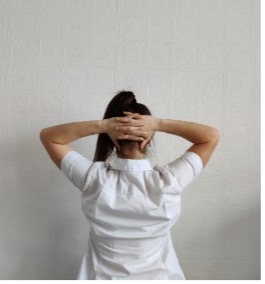Vagus Nerve Activation Exercises
- Meryl
- May 16, 2021
- 4 min read
Do you remember the last time you felt completely relaxed? A day when you weren’t thinking of your schedule for the next week, or overthinking the repercussions of not completing a task? Do you remember the last time you didn’t feel on edge? Are you in need of something to get away from the anxiety, but not sure where to start? We get you!
This month's clinic reading was Stanley Rosenberg's "Accessing the healing power of the vagus nerve" for tips on how we can use our parasympathetics to navigate through tricky times of stress and anxiety.

As human beings, we have evolved to thrive in social settings, and according to Rosenberg, our mind and bodies are at ease, relaxed and best able to recharge when we are socially engaged, aka feeling safe and loved in an environment that we trust. This could mean a fun gathering with close friends, walking on the beach with a family member, or cuddling up with your partner while watching a movie. The ability to socially engage, relax, and feel safe, is mainly governed by the vagus nerve.
What is the vagus nerve? The main function of our nervous system is to control and communicate information throughout our body to keep it functioning. Our cranial nerves in particular help us engage with the outside world. One special cranial nerve, the vagus nerve, is the main component of our Parasympathetic nervous system-our 'rest and digest' state. It connects the brain to the neck and multiple organs so has a significant effect when stimulated. See below!

The opposite reaction is initiated through the sympathetic activity of the nervous system, preparing us for stressful situations-our fight or flight state. This is responsible for increasing alertness, energy levels, heart rate and breathing rate so we can cope with the situation at hand. When the threat or stressful event ceases, our parasympathetic activity (rest and digest) increases again, making us feel safe and relaxed.
In our current working society, however, we understand how hard it is to find this balance between a relaxed mindset and the commitments/responsibilities of modern life. It can be difficult to maintain a constant state of balance without falling back into a vicious cycle of chronic stress when life events occur (think new job, baby, moving house, bereavement etc!).
When stress becomes a prevalent factor in our daily lives, the sympathetic activity can become “overactive”, and eventually lead to the suppression of the parasympathetic response, inhibiting the vagus nerve, and we start suffering from symptoms such as:
Stress
Anxiety
Gain/loss of weight
Irritability
Fearfulness with no cause
Feeling withdrawn
Depression
Exhaustion
Conditions associated with the above e.g. IBS, Hypertension
As health professionals, we Osteopaths want to help you achieve your optimal health. To do so we combine lifestyle advice, self-management tools and manual therapy to empower you to take control of your health! Just as we'd recommend stability exercises aimed at your knee or ankle, you can also perform exercises aimed at freeing surrounding structures and returning the vagus nerve to full function. These parasympathetic-stimulating exercises are often recommended to our patients in-order to help alleviate the manifestations of chronic stress and anxiety on the body.
With these four simple exercises, coupled with diaphragm breathing and a little perseverance, we are confident that you will be able to start this journey towards more stress-free days.
The Basic ExerciseThe main aim of these exercise will be to restore free movement in the head, neck and thoracic spine, relax the surrounding muscles, and increase the blood flow to the brainstem, which is the origin of the vagus nerve.
1. Start by lying comfortably on your back and weave your fingers together leaving your thumbs free. Put your hands on the back of your head, and let the weight of it rest on your fingers.
Keeping your head still, look to your right and keep the position for thirty to sixty seconds. After this short period, move your eyes to to look at your left.
During the exercise you might notice yourself sighing, yawning or swallowing, this is a sign of relaxation.
If you feel dizzy while sitting back up, it is probably due to your blood pressure lowering during the exercise. Take your time to slowly move out of the exercise when finished.
The Salamander exercise2. Sitting comfortably upright in a chair, bring your ear close to your shoulder into a neck side-bend. Place your hand on your head and rest it there, without pushing, and as the Basic exercise, look to your right for thirty to sixty seconds, and then to your left for the same amount of time.
Return slowly your head to an upright position taking a deep breath in, and repeat the exercise on the opposite side.
3. Similar to the exercise above, reach across your ribs with your arm to get a nice thoracic sidebend, stimulating the whole length of the vagus nerve pathway while increasing your spinal and rib mobility and improving breathing mechanics at the same time.
Again, look to your right for thirty to sixty seconds, and then to your left; slowly release your hand from the head and ribs and repeat the exercise on the opposite side.
Using your breath in an optimally controlled manner allows more air and oxygen in your body to let the brain (and vagus nerve) know that you feel safe and relaxed, which improves and facilitates vagal activity. This is why breathing exercises, (diaphragm, nasal, box breathing etc) help to restore a state of relaxation and control-great tools to use when nerves or stress are rearing their ugly heads! Try thoracic and chest opening exercises to improve your rib expansion and notice how much easier those breathing exercises become!
Hopefully you can see how a bit of movement, and a dash of persistence, could help you along, getting you closer to your much needed stress free days with a nice warm cup of relaxation! We're big fans of self-care so recommend the Salamander exercise as part of your Sunday down-time or in your lunch break...
Have a go at implementing more rest than stress in to your week and let us know how you get on!
Meryl x


























